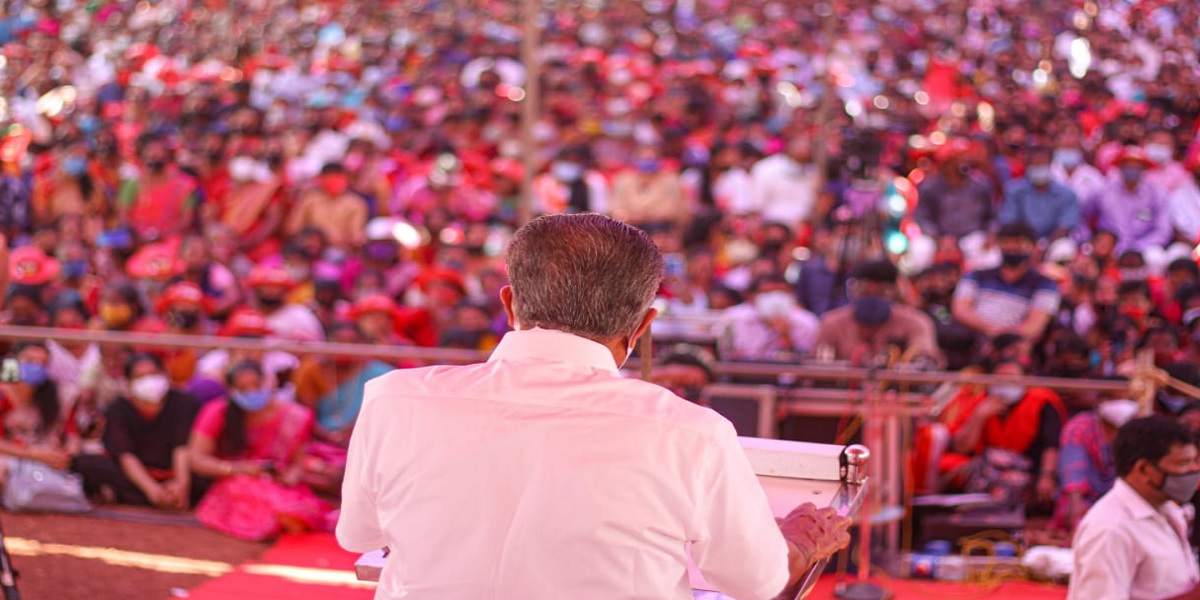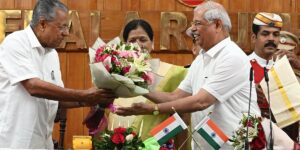On 20 May, as the LDF marked four years in power in its second consecutive term, the chief minister addressed the people to showcase the achievements and acknowledge the challenges of his government.
Published May 22, 2025 | 9:00 AM ⚊ Updated May 22, 2025 | 9:00 AM

Kerala Chief Minister Pinarayi Vijayan addressing a rally.
Synopsis: The second Pinarayi Vijayan government faced numerous challenges in the form of political controversies, administrative lapses, and public unrest as it completed its fourth year in office. Before the Assembly elections, the results from Nilambur and the upcoming local body polls will serve as a sample progress card for the Pinarayi government.
On 16 March 2020, a new form of political intimacy emerged in Kerala. As the world grappled with the uncertainty of the Covid-19 pandemic, Chief Minister Pinarayi Vijayan entered living rooms across the state every evening at 6 pm, becoming, for many, a steady voice of reason in a sea of fear.
In his calm, methodical briefings, the chief minister shared updates, relief measures, and key policies impacting Kerala’s 3.48 crore people, including migrants and the diaspora. More than just updates, these daily meetings fostered trust, mitigated misinformation, and established a new model of leadership in Kerala.
On Tuesday, 20 May, as the LDF marked four years in power in its second consecutive term, the chief minister once again addressed the people to showcase the achievements and acknowledge the challenges of his government.
While the Congress-led UDF observed 20 May as a “Black Day” in protest, the LDF projected strength and continuity. A detailed progress report is set to be released in Thiruvananthapuram on Friday, 23 May, promising a transparent evaluation of both triumphs and shortcomings.
While political parties in the state have begun preparations for the upcoming Assembly elections, the LDF remains confident of retaining power. However, a comparison between the first and second Pinarayi Vijayan governments offers a clearer picture of the political trajectory ahead, possibly even hinting at a major political shift.
It is time to critically examine what Kerala has gained, lost, and endured under Pinarayi’s leadership.
Marking four years of the LDF government, Chief Minister Pinarayi Vijayan spotlighted Kerala’s strides in infrastructure, health, education and welfare under the Navakeralam (New Kerala) vision in Kozhikode. Key projects like Vizhinjam port, Kochi Metro, and the national highway expansion were emphasised.
He cited record appointments by the state Public Service Commission (PSC), 4.5 lakh homes built under LIFE Mission, disbursal of ₹7,000 crore in free healthcare, and AI-enabled education reforms. Welfare pensions, IT sector growth, tourism revival, and effective disaster response were also noted.
Political analyst Ajay Nath told South First that the first Pinarayi Vijayan government is remembered not for calm governance but for navigating Kerala through some of its darkest hours, Nipah, back-to-back floods, and a global pandemic.

A viral image during the Kerala floods.
”No other government in Kerala’s history has faced such a barrage of crises. What won Pinarayi and his team a second term was their resolute and effective handling of these challenges,” Ajay said.
He pointed out that several people-centric initiatives were born during that time. Kudumbashree’s restaurants transformed into community kitchens during the floods.
Under Education Minister C Raveendranath, often overlooked by mainstream media, Kerala witnessed a silent revolution. Students received textbooks on time for the first time, and the state’s digital classroom transformation began.
His successor, V Sivankutty, continued this momentum and elevated Kerala’s education standards further in the second term.
Similarly, G Sudhakaran laid the groundwork for Kerala’s improved road and infrastructure development, a vision now being executed by Public Works Department Minister Mohammed Riyas.
Finance Minister Thomas Isaac played a critical role in preparing Kerala’s economy to weather disasters with minimal disruption, thanks to his forward-looking approach. The appointment of K Radhakrishnan as Kerala’s first Dalit Devaswom Minister marked a significant social milestone.
And above all, Health Minister KK Shailaja won international acclaim for her leadership during the Nipah outbreak and the first wave of Covid-19, turning Kerala into a global model for crisis response.
However, the term wasn’t without turbulence. The Chief Minister’s Office (CMO) was rocked by the gold smuggling scandal, leading to the removal of Pinarayi’s Principal Secretary amid public outrage over alleged links to accused Swapna Suresh.
Still, Ajay Nath believes that initiatives like free food kits during the floods and the pandemic helped the government regain public trust and maintain its hold on power.
The second Pinarayi Vijayan government faced numerous challenges in the form of political controversies, administrative lapses, and public unrest as it completed its fourth year in office.
The administration also endured internal rifts and dissent from within the Left camp. Former Nilambur MLA PV Anvar, once a loyalist, turned critic, lashing out at the police and party leadership during the Thrissur Pooram controversy and even targeting ADGP MR Ajith Kumar for alleged Rashtriya Swayamsevak Sangh (RSS) ties.
Anvar’s exit brought down the government’s MLA count, and the upcoming Nilambur by-election, if held before the local body polls, could prove politically significant.
It is also noteworthy that the BJP’s Suresh Gopi won the Thrissur Lok Sabha seat, which drew criticism from CPI, an ally of the CPI(M).
The death of Kannur Additional District Magistrate K Naveen Babu sparked a series of serious allegations, adding to the turbulence. The episode involving CPI(M) leader and former Kannur District Panchayat president PP Divya further fuelled public criticism against the government.
The Serious Fraud Investigation Office (SFIO) investigation involving the chief minister’s daughter Veena, protests by ASHA workers, and the emotional retreat of women civil police officers after a failed protest at the Secretariat also shook the administration.
Wayanad landslides, continued wild animal attacks, the growing drug menace and rising violence have subjected the state government to recurring criticisms.
Despite the noise, the government has pushed ahead with an aggressive reform agenda. It approved contentious decisions such as inviting private universities to the state and allowing liquor sales within IT parks, moves that raised eyebrows even among supporters, including the CPI. In the Palakkad brewery case, also, the CPI clashed with the CPI(M), further straining the LDF alliance.

On his first day in office, Kerala Governor Rajendra Viswanath Arlekar made a decisive move by reinstating the security personnel who had served under his predecessor, Arif Mohammed Khan.(X)
However, according to Ajay, ”Pinarayi’s leadership is visible even in crisis. CPI, NCP, and others raised issues, but see how effectively the CM handled all those noises within the LDF.”
The longstanding friction with former Governor Arif Mohammed Khan, who often mirrored the Opposition in tone and stance, appears to have eased following the arrival of a new Governor.
Yet, the administration has signalled its readiness to challenge constitutional authorities, legally contesting the Union government’s financial controls and even taking on the Governor and the President over stalled legislation.
In terms of development, the government highlights the successful execution of projects once dismissed as pipe dreams, the GAIL gas pipeline, national highway expansions, the Kochi-Edamon power highway, the Puthuvypeen LPG terminal, and the Vizhinjam port.
Since the Pinarayi Vijayan-led government came to power in 2016, Kerala has witnessed 13 by-elections, ten for the Legislative Assembly and three for the Lok Sabha.
A closer look reveals that the LDF has been the primary beneficiary of these elections. The Assembly by-polls took place in Vengara (2017), Chengannur (2018), and in Pala, Manjeshwaram, Ernakulam, Aroor, Konni, and Vattiyoorkavu in 2019.
More recently, by-elections were held in Palakkad and Chelakkara. In these contests, the LDF managed to wrest three Assembly seats, Pala, Konni, and Vattiyoorkavu, from the UDF, while the UDF was able to win only one seat, Aroor, from the LDF.
The by-elections in Palakkad and Chelakkara came under particular scrutiny. Allegations that Rahul Mamkootathil was a nominated candidate created friction, but he eventually won with a record majority, silencing critics. Meanwhile, Chelakkara was retained comfortably by CPI(M), offering a moment of reassurance for the LDF.
As for the Lok Sabha, three by-elections have been held since 2016, two in Malappuram (2017 and 2021) and one in Wayanad (2024).
Wayanad’s by-election in 2024 followed Rahul Gandhi’s re-election from the seat in the general election, where his majority dropped from 4.31 lakh in 2019 to 3.64 lakh. The UDF had hoped that fielding Priyanka Gandhi would boost the majority, but initial reports suggested low voter turnout.
Yet, Priyanka eventually won with a resounding 4.04 lakh majority, exceeding Rahul’s 2024 numbers and putting UDF concerns to rest.
Overall, while the UDF managed to hold its ground in select strongholds, the LDF clearly gained more during the Pinarayi era, particularly in the crucial 2019 by-elections, marking a significant political shift in Kerala’s electoral landscape.
Before the Assembly elections, the results from Nilambur and the upcoming local body polls will serve as a sample progress card for the Pinarayi government.
(Edited by Muhammed Fazil.)
